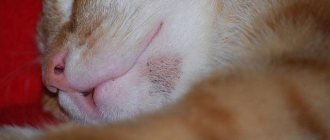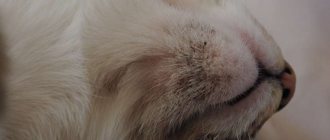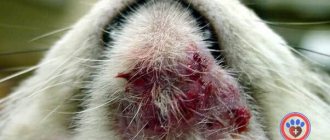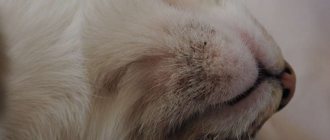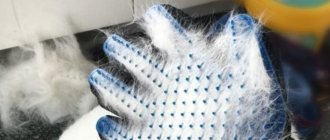The appearance of black dots that look like dirt on a cat's chin indicates the development of acne. Sometimes pathogenic bacterial microflora is involved in the process and inflammation occurs, pustules with pus are formed. To prevent the development of such pathologies, owners should be aware of measures to prevent the appearance of black spots on a cat’s chin, as well as methods of treating them.
What is acne?
Acne in cats is not a very common disease. Therefore, the appearance of acne in the area of the chin, abdomen, mouth, ears and base of the tail causes some surprise in a person.
This dermatological pathology is associated with improper functioning of the sebaceous glands - as a result, pores are clogged and a serious disturbance in metabolic processes occurs.
The pores are closed by old epithelium, which is glued to new cells by fatty secretions. This causes black or white pimples to form. The type of rash depends on where the blockage occurs and the sebaceous plug appears - inside or outside the pore. If the process is not accompanied by infection, the skin problem may disappear on its own.
Causes of acne in cats
There are at least two types of factors influencing the occurrence of acne: endogenous and exogenous.
- Endogenous, that is, having an internal origin, include hormonal imbalances, impaired metabolism, and poor liver function.
- Exogenous causes mainly arise as a result of poor care of the animal, when fatty food debris accumulates in the chin area, which can clog the pores and the mouth of the hair follicle.
There are also mechanical acne, but this type of acne is quite problematic to encounter in cats. The appearance of mechanical acne can be caused by scratching, cracks in the skin and other impurities.
Causes of acne
The appearance of skin pathologies accompanies animals of different ages and breeds. Anomalies in the functioning of the sebaceous glands most often affect furry cats with weakened immune systems and poor living conditions. In advanced cases, the animal experiences great discomfort, which later develops into infectious diseases and dermatitis. It has been established that the appearance of acne in cats has different causes; they can be conditionally divided into two large groups - external and internal.
External factors
Veterinarians cannot absolutely accurately name the problems that lead to dermatological pathologies. One of the most common external factors in the appearance of acne is considered to be improper or insufficient care of the owner for his pet.
Acne on a cat's chin occurs because it is difficult for her to lick this part herself. As a result, sebaceous plugs oxidize and clog skin pores. Other causes of acne in cats are:
- improper diet;
- taking certain medications;
- experienced stressful conditions;
- poor place of detention - too humid, stuffy, etc.;
- dirty place for the cat to feed and rest.
Interestingly, skin diseases also appear as a reaction to surrounding objects. For example, a negative reaction is caused by low-quality plastic, from which bowls for eating and drinking are made. Daily contact with such material leads to the appearance of black spots on the chin of a pet.
At-risk groups
Some experts claim that the causes of acne in cats are not related to the gender, age or breed of the mustachioed friend, while others talk about certain patterns. For example, animals after undergoing sterilization and castration are least susceptible to blockage of the sebaceous glands.
Long-haired individuals are more likely to suffer from acne, which appears in the folds and on the face. In animals with short hair, inflammation occurs mainly on the chin. Black dots are most visible in bald individuals who have increased sebum secretion.
Diseases with similar symptoms
There are a number of diseases whose symptoms include the appearance of rashes and acne:
- Scabies. In addition to rashes, the main symptom is severe itching, which leads to hair loss.
- Allergy. Often accompanied by the appearance of acne, it occurs due to poor nutrition or a reaction to toilet filler.
- Presence of skin and subcutaneous parasites. Acne is often confused with the remains of dried blood, indicating the presence of fleas. The difference is that, unlike acne, they can be easily removed from the surface of your pet’s skin.
- Demodecosis. The root cause is tick bites, which cause itching, redness and rash. If ignored for a long time, it can be fatal.
- Dermatitis. Complications arising from acne or a reaction to the presence of parasites.
You should contact a veterinarian if serious complications arise that can negatively affect the health of your pet, and if it is not possible to make an accurate diagnosis, as well as select an acceptable treatment at home on your own. In this case, the specialist will take a scraping from the animal, determine the disease and prescribe the necessary treatment.
Symptoms, distinctive features, stages
Sometimes black spots on a pet's skin form and disappear without the owner noticing. This is explained by the fact that the mustachioer does not experience any discomfort and does not scratch the problematic part of the body. Acne goes away on its own thanks to a strong immune system.
However, repeated inflammation causes significant suffering for the furry ones. An attentive owner will notice the changes that occur on the animal’s body.
In addition, the behavior of the mustache also changes. He is constantly irritated, becomes restless, begins to refuse food, and is constantly itching. External symptoms may go through the following stages:
- Initially, redness of the skin appears.
- There are more pimples, and in appearance they look like dirt on the fur.
- The affected part of the body begins to swell and increase in size.
- Gradually, ulcers and inflammation of the follicles appear.
- Crusts of pus and blood form on scratched areas.
- The last stage is the loss of fur in the affected areas.
It is important to notice dermatological problems with your pet’s skin at the initial stage. If the owner takes action in time, the patient will get rid of the pathology much faster. Relapse is caused by incorrect or delayed treatment.
On what parts of the body do blackheads usually appear?
Sebaceous glands are located throughout the pet's body. Owners online show cat acne in photos, and there it is most often localized in the area of the lips and chin.
If the pathology remains unnoticed, then acne can subsequently spread to other parts of the cat’s body. Particularly affected are areas that are constantly exposed to dirt or cannot be thoroughly cleaned. For example, the area around the tail, armpits, nose and bridge of the nose.
Video
Authors):
Gerke A.N., Ph.D., dermatologist at the SovVet veterinary clinic, member of the European Society of Veterinary Dermatologists (ESVD), St. Petersburg
Journal:
No. 2-2021
Key words:
Feline acne
Keywords
: acne, cat
Summary
Feline acne is a common skin disease in the cat, that is believed to be an idiopathic disorder of follicular keratinization, and secondary infection is an important component of feline acne and the identification of these bacterial and fungal organisms may improve treatment outcome. Feline acne lesions were defined as comedones, crusts, erythema, alopecia, papules, swelling, pustules, nodules/fistulas, and scarring of the chin. Pruritus was reported in 35% of the affected cats. For treatment, mainly local topical therapy is used, including hygiene procedures, drugs containing benzoyl peroxide, mupirocin. In some cases, systemic antibiotic therapy is indicated.
annotation
Feline acne is a common skin disease in cats associated with impaired keratinization and secondary infection (bacterial or fungal), the identification of which is necessary for effective therapy. Clinical signs of feline acne include comedones, crusts, erythema, alopecia, papules, edema, pustules, nodules with fistulas, and scarring in the chin area. Itching occurs in 35% of cats. For treatment, local therapy is predominantly used, including hygiene procedures, drugs containing benzoyl peroxide, mupirocin. In some cases, systemic antibiotic therapy is indicated.
Photo 1. Comedones in the chin area of a cat with acne
Not
Introduction
Feline acne is a common skin disease of cats associated with an idiopathic disorder of follicular keratinization. While some cats experience spontaneous regression and this may be the only episode of acne in their lives, in others the disease recurs and is regularly complicated by severe furunculosis. The pathogenesis of this problem is not fully known; it is believed that predisposing factors may be insufficient grooming, stress, a tendency to seborrheic disorders, excessive secretion of the sebaceous glands, immunosuppression, including those associated with chronic viral infections. However, none of these reasons is mandatory in every clinical case. Acne in cats, as a rule, is not associated with hormonal imbalances.
Photo 2. Comedones, alopecia, erythema, papules in a cat with acne due to food allergies. The lesions are accompanied by itching.
Clinical signs
Clinically, feline acne may present as comedones, crusts, erythema, alopecia, papules, edema, pustules, nodules, fistulas, or scars (Table 1). The first clinical manifestations may be crusts and comedones on the skin of the chin and on the border with the lower lip, less often on the upper lip and the commissure area. Since no other symptoms are observed at this stage, owners usually do not notice signs of illness in their pet. In some cats, acne does not progress, remaining at the comedonal stage for a long time, while in others papules and pustules appear. In severe cases, purulent folliculitis, furunculosis or cellulitis develops. In severe cases, swelling of the chin and lips develops, and cats begin to intensively rub their chin on the surface and scratch with their paws. Regional lymphadenopathy rarely develops. Formation of follicular cysts and cicatricial alopecia is also possible in severe chronic cases. In most cases, lesions in the chin area may be the only cutaneous manifestation. Cats that, in addition to the characteristic lesions of the chin area, also have comedones, crusts, erythema and self-induced alopecia due to excessive licking in the area of the limbs, abdomen, groin, and muzzle, as a rule, have “atopic dermatitis” and require a systematic approach to diagnosis and therapy. Feline acne can develop at any age; there is no obvious breed or sex predisposition, but according to one review, male cats are more susceptible [3].
Table 1. Clinical signs of feline acne [3]
| Clinical sign | Occurrence (%) |
| comedones | 73% |
| alopecia | 68% |
| crusts | 55% |
| papules | 45% |
| erythema | 41% |
| edema | 18% |
| pustules | 9% |
| nodules/fistulas | 9% |
| scarring | 4,5% |
| itching | 35% |
Pathogenesis and histological changes
Histological examination reveals dilation and blockage of the sebaceous gland ducts with a lymphoplasmacytic inflammatory reaction of the duct walls. In a chronic course, fibrosis of the ducts may develop. In some cats with acne, pyogranulomatous inflammation of the sebaceous glands is also detected. Often mural or even purulent folliculitis occurs with the development of furunculosis; in these cases, purulent exudate in the lumen of the follicles is revealed in the histobiopsy [3].
Photo 3. Acne complicated by furunculosis of bacterial etiology
Diagnostics
In most cases, the diagnosis is based on the characteristic clinical manifestations of lesions in the chin and lips. At the stage of comedones, the first diagnostic step after collecting history data, clinical examination and luminescent diagnostics is microscopy of skin scrapings to exclude feline demodicosis and cytological examination to identify Malassezia yeast-like fungi, bacteria, assess the nature of inflammation (eosinophilic, septic or sterile neutrophilic, pyogranulomatous, etc. .P.). Dermatophytosis should also be excluded, although it is extremely unlikely that acne will be the only manifestation of the infection, it is nevertheless worth considering the possibility of M. canis infection in cats, especially from shelters and dysfunctional catteries [4].
In furunculosis, it is necessary to identify a primary or secondary infectious cause through cytology and possibly bacteriology. The most common bacterial agents identified in feline acne are Escherichia coli,
alpha-hemolytic
Streptococcus
, coagulase-positive
Staphylococcus s, Bacillus cereus, Micrococcus sp.
Pseudomonas aeruginosa and others [4]. It is important to note that these bacteria can also be detected from the chin skin of clinically healthy cats, so the main etiological factors are disruption of the skin barrier, immunosuppression and defects in keratinization. Bacterial furunculosis that does not respond to empirical antibiotic therapy may require bacteriological testing.
In cases of severe swelling of the chin, a likely diagnosis may be feline eosinophilic granuloma complex, in which case cytological examination may reveal many eosinophils. Such cats are diagnosed with allergies, including regular treatments for parasites, exclusion diets, and drug therapy is selected.
If viral infections are suspected, PCR tests are performed on skin biopsies to detect the herpes virus (feline herpes virus-1) and feline calicivirus. Based on immunohistochemistry studies [3], these common feline viral infections do not appear to be the primary cause of acne in cats. However, these infections must be taken into account in ulcerative lesions accompanied by eosinophilic inflammation, since immunosuppressive therapy in these cases may worsen the patient's condition.
Feline herpesvirus infection caused by FHV-1 has been described as a cause of ulcerative skin lesions in the muzzle and dorsum of the nose. On histological examination, the characteristic cutaneous manifestations of FHV-1 are vesicles, ulcers, crusts, and necrosis, often with eosinophilic infiltration [1].
There is a report on the use of immunohistochemistry to confirm calicivirus as the cause of acne in cats that is refractory to standard therapy [3]. Calicivirus infection of cats is usually characterized by damage to the upper respiratory tract, erosive-ulcerative glossitis, chronic lymphoplasmacytic or proliferative stomatitis, pneumonia, and damage to the paw pads, accompanied by lameness. Cutaneous manifestations of calicivirus include swelling of the skin (usually the distal parts of the extremities), alopecia, crusted lesions most often in the nose, lips, ears, paws and lesions around the eyes. One of the rare manifestations of calicivirus, along with skin manifestations, is also febrile hemorrhagic syndrome [2], leading to death in 50% of cases. This syndrome is accompanied by fever, anorexia, jaundice, vomiting, diarrhea and respiratory manifestations. Skin lesions first appear on the paw pads and consist of neutrophilic inflammation and necrosis. Histological examination of the skin with calicivirosis reveals necrosis of the basal and spinous layers, as well as the follicular epidermis and ulceration of the skin. In the most chronic cases, necrosis of all layers of the epidermis with balloon degeneration of the surface layers is detected; the boundaries of the epithelium and subepithelial structures appear blurred. The deepest lesions are observed at the border of the skin covered with hair and hairless areas. The study found that only a portion of cats that had clinical manifestations and characteristic histological and immunohistochemical changes in skin biopsies had the antigen detected by PCR [3].
If feline demodicosis caused by Demodex cati is confirmed,
it is necessary to find the causes of immunosuppression, which may be drugs, chronic diseases, including chronic viral infections caused by the immunodeficiency virus (FIV) and feline leukemia virus (FeLV).
Treatment
The need and intensity of therapy depends on the degree of clinical manifestations. If the cat owner does not pay attention to comedones, and this is the only clinical sign, then there is no need to prescribe treatment for such an animal. If the lesions progress, are complicated by secondary infection, or are accompanied by itching, therapy is necessary.
In most cases of feline acne, topical therapy is preferred. It is recommended to pre-cut the hair in the affected area for ease of application and increase effectiveness. If you have fistulas and boils, you can make lotions with a warm solution of magnesium sulfate (2 tablespoons per liter of water) for 5 to 10 minutes. In the presence of boils and fistulas caused by a bacterial infection, use appropriate antibiotics orally for 14 to 21 days. The choice of antibiotic depends on the type and sensitivity of microorganisms; in most cases, amoxicillin-clavulanate, fluoroquinolones or cephalosporins can be used for empirical therapy [4]. Alcohol-containing preparations, various cleansing wipes, and the antiseptic Listerine can be used as comedolytic agents, however, most researchers prefer the use of antiseborrheic shampoos containing ethyl lactate or benzoyl peroxide on a daily to twice weekly basis. Benzoyl peroxide has significant benefits in helping to unclog hair follicles, but may cause irritation in some cats, in which case it should be discontinued. The use of gels and lotions containing metronidazole, clindamycin, tetracycline, or erythromycin has also been described. Topical treatments with mupirocin may reduce the need for systemic therapy. Applying mupirocin cream twice a day is most effective [5].
As clinical recovery progresses (in the absence of papules and comedones), treatment can be gradually discontinued over several weeks. For cats with a history of recurrent acne, regular cleansing procedures are recommended.
Some cats benefit from fatty acid supplementation.
Other than antibiotic therapy and fatty acid supplementation, systemic therapy is rarely necessary. Cats with severe inflammation may be given an additional course of prednisolone for 10–14 days at a dose of 1–2 mg/kg per day orally, which can improve the condition and reduce scarring. However, any bacterial infections must be controlled before corticosteroids are prescribed.
In the absence of positive dynamics during local therapy, the administration of isotretinoin orally at a dose of 2 mg/kg/day is described. Positive dynamics of this therapy are observed only after 30 days in 30% of cats with acne. As the drug improves, the drug intake is reduced to once every 2–3 days [5].
Literature
1. Hargis AM, Ginn PE Feline herpesvirus-1-associated facial and nasal dermatitis and stomatitis in domestic cats. /Veterinary Clinics of North America Small Animal Practice, 1999; 6: 1281 – 1290.
2. Hurley K., Sykes J. Update on feline calicivirus: new trends. /The Veterinary Clinics of North America: Small Animal Practice, 2003; 33: 759 – 772.
3. Jazic E., Coyner KS, Loeffler DG, Lewis TP An evaluation of the clinical, cytological, infectious and histopathological features of feline acne./Veterinary Dermatology, 2006; 17 (2): 134 -140.
4. Scott DW, Miller WH, Griffin CE Keratinization defects / Muller and Kirk's Small Animal Dermatology, 6th edn. Philadelphia: WB Saunders, 2001: 1042 – 1043.
5. White SD, Bordeau PB, Blumstein Ph., Ibisch C., Ère EG, Denerolle Ph., Carlotti DN, Scott KV Feline acne and results of treatment with mupirocin in an open clinical trial: 25 cases (1994–96) / Veterinary Dermatology, 1997;
8 (3): 157 – 164. Back to section
Carrying out diagnostics
It is impossible to find out for yourself what kind of black marks appeared on the body of a pet. Even with some experience and knowledge, the patient’s owner will not be able to make an accurate diagnosis. To determine the nature of the skin rash, you must consult a veterinarian.
The doctor will examine the patient and find out details about the animal’s nutrition. Information about the last vaccination and deworming performed will be important for making a diagnosis. For an accurate clinical picture, diagnostic procedures can be performed:
- Scraping from the diseased area to determine the pathogenic microorganism.
- Blood sampling for serological analysis aimed at excluding other similar diseases.
- Bacteriological culture to determine the type of pathogen.
- A biopsy prescribed to identify benign or malignant neoplasms.
As a result, the veterinarian will have all the data to make an accurate diagnosis and develop a treatment regimen. The therapy prescribed by the doctor will be aimed at symptomatic elimination of skin manifestations and relief of negative consequences.
Diagnostics in a veterinary clinic
Going to the clinic with your pet is mandatory, since the symptoms of acne are similar in their symptoms to such dangerous diseases as sarcoptic mange (scabies), eosinophilic (linear) granuloma, demodicosis (subcutaneous mite), dermatomycosis (ringworm). The appearance of acne can also be associated with an allergic reaction.
To make an accurate diagnosis, the clinic will take a skin scraping from your pet for analysis. The biomaterial is studied for the presence of bacteria and fungi.
The results of the analysis, if they confirm acne, will allow the doctor to prescribe the correct treatment and recommend that the animal owner eliminate possible household factors that irritate the animal’s skin or make changes to its diet.
How to cure cat acne
Acne in cats can be treated at home. If you strictly follow the prescriptions and recommendations of the veterinarian, you will be able to help your sick pet quickly enough.
The choice of medications is explained by the age, characteristics of the patient’s body, as well as the complexity of the clinical picture of the disease. If a repeated manifestation of skin pathology is recorded, then the prescribed drugs are much more aggressive. It is important for the owner to follow the recommendations on the dosage and duration of medication use.
Ointments, shampoos and folk remedies
The veterinarian prescribes local or complex therapy. When diagnosing acne in cats, the doctor determines how to treat the patient. Therapy depends on the frequency of skin rashes and the severity of the disease. The main recommendation from a specialist is not to squeeze out mature acne and not to self-medicate. The following can be used as effective medicines:
- Percutan ointment
, applied twice a day until the problem disappears completely. Furacilin, which is the main component of the drug, dyes the hair yellow; there is no need to be afraid of this.
- Mupirocin ointment
(Bactroban), used to treat damaged areas during re-infection, formation of purulent and bloody crusts.
- Prednisolone ointment
is prescribed in case of severe inflammation, as it contains powerful substances - corticosteroids. They have a strong anti-inflammatory and healing effect.
Doctors do not recommend frequent use of antiseptic compounds: chlorhexidine, hydrogen peroxide, miramistin, boric or salicylic alcohol, iodine. Their constant application leads to dry skin. Instead, they are treated with shampoos and soaps with antiseborrheic properties. For example, tar soap has proven itself well.
As additional measures, you can use folk remedies. To get rid of blackheads and inflammation, prepare an infusion of chamomile and calendula, in which two furatsilin tablets are dissolved. Apply the liquid to the affected parts twice a day. Pieces of fresh pumpkin, which are used to wipe acne three times a day, help well.
Diet
You can speed up the treatment of cat acne with the right diet. The veterinarian immediately prescribes a diet of low-fat foods. During therapy, as in ordinary life, it is impossible to feed the patient food from the master’s table. Such food contains a large amount of preservatives and flavor enhancers that are harmful to pets.
The patient's diet should consist of foods that do not cause allergies: lean meat, offal, cereals. As auxiliary elements, the pet is given vitamin and mineral supplements, Omega-3 and Omega-6 acids.
If the cat eats commercial food, the doctor will recommend a low-fat dietary product in the form of granules or pates.
Hygiene procedures
Getting rid of acne in cats using home treatment without veterinarian advice is difficult. Only in combination with hygienic procedures and proper conditions for keeping the patient is a guaranteed cure possible.
Acne in cats on the chin without treatment leads to the formation of large ulcers. Without proper hygiene, pathogenic microorganisms will penetrate inside and lead to complications. What actions should be taken to maintain hygiene:
- Treat affected parts of the body with medicinal ointments prescribed by a veterinarian.
- Before using the preparations, disinfect the skin with a 3% solution of hydrogen peroxide - if there are wounds.
- For long-haired pets, it is necessary to trim or shave the hair on the affected area during treatment.
- If the points are located on the face (for example, on the chin), after eating you need to wipe your pet’s mouth to remove food debris.
It is important to pay attention to what your pet comes into contact with. It is advisable to replace plastic bowls for water and food with iron, ceramic or glass. If your furry dog wears a collar, it must be removed during treatment. This will avoid rubbing the affected areas and re-infection.
Do I need to contact a veterinarian?
Only a veterinarian can determine the nature of the appearance of skin rashes on the body of an animal. Examination of the patient and conducting additional studies are of great importance for making the correct diagnosis.
Skin scrapings and analysis for the presence of fungal or parasitic diseases will help to exclude diseases with similar symptoms: scabies, granuloma, allergies, demodicosis, dermatophytosis.
Treatment of black spots on a cat's chin and prognosis
It is not advisable to treat acne at the comedonal stage (when single black dots are visible on the cat’s chin), since therapy is required only at the stage of pustules or boils. The veterinarian informs the owner about this and gives him clear instructions regarding further monitoring of the disease.
The opening of the boil is carried out only after the formation of the connective tissue capsule. When trying to squeeze out an immature abscess in a cat, pathogenic microorganisms can enter the systemic bloodstream and cause sepsis.
Important! To eliminate the pathology, complex treatment is necessary, which includes local and systemic therapy. If deep boils are present, surgery may be necessary.
Local therapy
First, the hair on the chin of a kitten or adult cat is trimmed. Further treatment is carried out according to the following scheme:
- daily cleansing of the skin with antiseborrheic shampoos, which contain salicylic alcohol or ethyl lactate (used until the clinical manifestations of the disease disappear);
- treatment of the affected area with a 1% chlorhexidine solution;
- lubricating acne with antibacterial ointments or lotions.
Important! After eliminating the clinical signs of acne, doctors recommend continuing to treat the skin with antiseborrheic shampoos 2 times a week for a month to prevent the development of relapses.
The dangers of cat acne
Pathologies caused by blockage and further inflammation of the sebaceous glands are not always considered by owners to be serious problems. However, acne should not be left unattended.
For the animal itself
The pet experiences great discomfort from the accumulation of black spots on the chin, around the nose, mouth, and at the base of the tail. The cat scratches the affected areas of the body and brings dirt into the wounds. As a result, purulent ulcers and crusts of blood are formed. Pathogenic microorganisms can penetrate through them, causing dangerous infections that are long and difficult to treat.
For man
The skin pathology, which is unpleasant for the pet fluffy, is not contagious to the owner and his family members. Only infections that accompany an advanced form of illness (for example, lichen) can be dangerous to humans. Therefore, it is impossible not to treat and allow further spread of acne throughout the animal’s body.
Causes of the disease
Inflammation of the sebaceous glands in cats is a skin disease called acne. Acne appears in the form of blackheads or blackheads. The most common area of occurrence is the chin and lip area.
There are various reasons why this skin disease appears, the main ones are:
- stressful situations, which result in disruption of the sebaceous glands and the production of large amounts of sebum;
- poor hygiene when licking yourself in hard-to-reach places, such as the chin;
- skin diseases;
- allergy;
- disturbances in the development of the sebaceous glands;
- weak immunity;
- fatty food;
- the porosity of the material of plastic animal feeding bowls, allowing bacteria to accumulate in the pores due to irregular washing of dishes.
Prevention of acne in cats
The task of any owner is to provide proper care for his mustachioed friend. Thus, water and food bowls should be washed once a day and new food should not be added to a plate with old food.
Drinking water should always be fresh. If your pet has a tendency to form black spots, then after each meal you need to wipe its face.
Blackheads in cats usually affect the chin and areas around the mouth. Most owners do not attach importance to this skin disease, hoping for their pet to heal on its own. But lack of attention to this pathology can lead to serious problems. In order not to aggravate the situation, the owner must know the causes and methods of treating blackheads.
The article is for informational purposes only. Contact your veterinarian!
Do you like the article? 181
What are some skin diseases similar to acne in cats?
Before starting treatment , it is necessary to accurately determine the disease in your pet. Only a veterinarian will tell you the correct diagnosis after a thorough examination of the animal in the clinic. What appears on an animal’s face can indicate not only acne, but also other skin diseases. The symptoms of many diseases coincide, it is recommended not to draw hasty conclusions. The most similar causes in terms of symptoms:
- allergy,
- dermatophytosis condition,
- scabies,
- granuloma of the eosinophilic group,
- demodicosis reaction.
In order to completely exclude or confirm a fungal or parasitic group of skin lesions, a scraping study should be carried out. It is recommended not to jump to conclusions and make a diagnosis based only on symptoms. For an accurate diagnosis, laboratory data is required.
